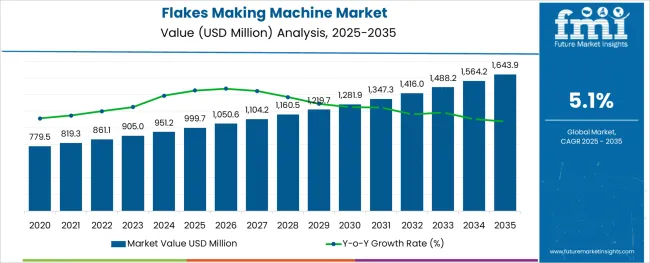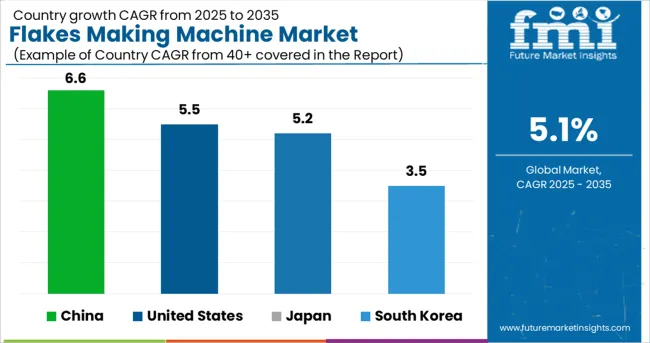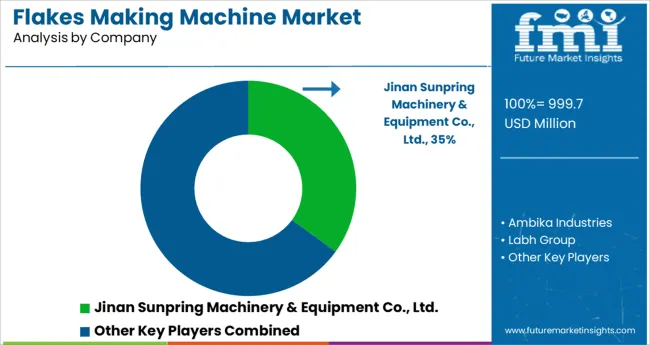The Flakes Making Machine Market is estimated to be valued at USD 999.7 million in 2025 and is projected to reach USD 1643.9 million by 2035, registering a compound annual growth rate (CAGR) of 5.1% over the forecast period.

The alginic acid market is undergoing consistent growth, propelled by rising demand from food processing, pharmaceutical formulations, and cosmetic applications. A growing focus on natural and sustainable ingredients in manufacturing processes has positioned alginic acid as a preferred biopolymer across industries.
The market is further supported by its diverse functional benefits, including water retention, gelling, and stabilizing properties, which make it indispensable in high-performance formulations. Increased regulatory acceptance of alginates as safe additives and the push towards cleaner labeling in food and personal care products have reinforced their adoption.
Ongoing innovation in extraction technologies and the utilization of algae as a renewable resource are paving the way for cost-effective production and expanded applications, ensuring sustained market expansion in the coming years.
The market is segmented by Operation and Sales Channel and region. By Operation, the market is divided into Automatic and Semi-Automatic. In terms of Sales Channel, the market is classified into Direct Procurement, eCommerce Platforms, and Other Channels. Regionally, the market is classified into North America, Latin America, Western Europe, Eastern Europe, Balkan & Baltic Countries, Russia & Belarus, Central Asia, East Asia, South Asia & Pacific, and the Middle East & Africa.
When segmented by salts, sodium alginate is expected to command 27.5% of the market revenue in 2025, marking it as the leading subsegment in this category. This leadership has been driven by its superior solubility, ease of incorporation into formulations, and versatility in a wide range of applications.
Its ability to form stable gels and maintain viscosity under varying conditions has made it highly sought after in both food and pharmaceutical sectors. Manufacturers have prioritized sodium alginate due to its consistent performance, cost-effectiveness, and regulatory acceptance, which have collectively strengthened its position.
The segment’s prominence has also been enhanced by its adaptability to evolving consumer preferences for plant-derived and sustainable ingredients, reinforcing its market share.
Segmented by end user industry, the food industry is projected to hold 33.0% of the market revenue in 2025, positioning it as the most prominent sector. This dominance has been shaped by the industry’s increasing reliance on alginic acid and its derivatives to deliver desirable textures, stabilize emulsions, and improve shelf life of processed foods.
As consumer demand for clean label and natural additives has intensified, the food sector has responded by integrating alginates into bakery, dairy, and confectionery products. Enhanced production efficiency and compliance with food safety standards have further encouraged widespread use.
The segment’s leadership has also been supported by product differentiation strategies where alginates contribute to premium quality and innovation, securing their role in modern food formulations.
The significant expansion of the ready-to-eat food sector in emerging economies is anticipated to be the main driver of demand for flakes-making machines. Given that the lure of not having to prepare meals after a long day at work is too alluring, an expanding global population is moving toward a busy lifestyle, which has significantly increased the demand for ready-to-eat and simple-to-prepare meals.
The consumption of packaged and nutritious foods has seen a dramatic increase in the past thanks to trends and the economy. The flakes-making machine market may have plenty of growth potential in the years to come due to the shift in dietary habits and the rise in the consumption of processed foods.
Over the past few years, there has been a noticeable rise in the burden of lifestyle diseases like diabetes, obesity, and others.
The International Diabetes Federation estimates that in India, 9.6% of the population, or close to 951.2 million people, would have diabetes by the year 2024.
Due to their high sugar and carbohydrate content, cereal flakes can increase blood sugar levels and risk of diabetes and heart disease; hence people with diabetes are consuming fewer of these foods. This is anticipated to reduce sales in the global flakes-making machine market on the whole.
The availability of substitute products like energy drinks, yogurt, eggs, fresh fruit, and yoga bars as well as the high lactose intolerance in the Far Eastern countries may be the main obstacles to the flakes-making machine market expansion.
More than 50% of edible flakes are eaten with milk, but due to the high lactose content of milk, most consumers find it difficult to digest milk for breakfast in the morning. This hinders the flakes-making machine market trends on the whole because when the demand for flakes to reduce the demand for flakes-making machines may be automatically affected.
The excellent quality of these machines, which major manufacturers work to produce, is the primary factor driving the sales of flakes-making machines. Several important players manufacture their machines using cutting-edge methods and premium components.
Additionally, they want to offer top-notch equipment to their loyal customers all around the world with the assistance of qualified technical professionals. In addition to producing cornflakes, these machines are also capable of producing jowar, poha, millets, etc.
The equipment is economical and consistently produces flakes at the highest throughputs. It is predicted that this may increase demand for flakes-making machines. Additionally, the flakes-making machine is ideal since it has a small footprint, an integrated control unit, and the requisite precision to flake everything from soft seeds to cracked soybeans.
Customers can make mechanical and hydraulic changes to modify the flake thickness while the machine is operating. This contributes to a reduction in overall operating costs and an improvement in production capacity, thus assisting in the expansion of the flakes-making machine market share.
According to the United Nations, the population is rapidly increasing, reaching 7.12 billion in 2013 and is expected to reach 9.6 billion by the end of 2050.
The primary cause of exponential population growth is increased life expectancy due to improved medical care and nutrition. This to lead to an increase in healthy processed food consumption, which might fuel the rising flakes-making machine market trend.
Food and beverage industry growth is being driven mostly by developing countries such as India, China, and Brazil, as economies improve and the middle-class population rises.
The semi-automatic flakes-making machine segment is expected to grow at the fastest CAGR of 4.8% between 2025 and 2035.
Whereas the automatic flakes-making machine is to follow it. Flakes processing lines are built in the sectors that process confectionery goods and make snacks. This device includes an extruder, a spiral elevator, and a mixer for flour, an oven, an air conveyor, and a spraying device. It can create shapes like rings, discs, stars, and rounds.
Corn flakes machine segment in the market for flakes making machine are expected to grow at the fastest CAGR of 5.4% between 2025 and 2035. The Corn flakes machine segment is expected to maintain its lead throughout the forecast period due to its widespread consumption among working-class people worldwide, particularly in North America and Europe.
Breakfast cereal is one of the largest markets in the USA. Furthermore, since the Kellogg brothers introduced cornflakes in the late 1800s in the USA, these products have maintained their popularity in the country to this day.
Rice flakes machines in the flakes-making machine market are expected to grow at the second fastest CAGR during the forecast period, owing to rising demand for healthy foods among the world's young people.
During the predicted period, the direct procurement channel had the highest share in the market for flake-making machines. Product sales through this channel are being driven by rising consumer desires for nutritious snacks with a wide range of tastes and long shelf life.
These consumer trends are expected to keep this distribution channel ahead of the competition over the projected period. For the forecast period, the eCommerce Platforms channel is expected to be the fastest expanding. The segment's growth is being aided by expanding e-commerce penetration as a result of increased internet and smartphone adoption around the world for the market for flakes-making machines.
Benefits such as doorstep delivery, easy accessibility, big discounts, and a wide range of product alternatives are driving sales of ready-to-eat products through the online distribution channel.
Additionally, due to changing consumer preferences, internet behemoths like Tesco.com, Walmart.com, Amazon Prime Pantry, Yihaodian, Godrej Nature's Basket, Alibaba, and Honestbee are aggressively expanding. The demand for flakes-making machines is anticipated to increase through this channel as a result of these market developments.

During the projection period of 2025 to 2035, North America is expected to expand the quickest in the flakes-making machine market, according to FMI.
Cereal fakes are quickly becoming a popular breakfast and snack option, especially among children in nations like the USA and Canada, as consumers' preferences for all-natural food products and the use of cereals rise across modernized civilizations. Therefore the adoption of flakes-making machines is also rising.
United States
United States is expected to expand the quickest in the flakes-making machine market with a CAGR of 5.5% for the forecast period of 2025 to 2035.
Due to the existence of nations with high morning cereal consumption, such as the USA, the USA has grown to be the largest regional flakes-making machine market with a share of USD 1643.9 Million by 2035.
Additionally, customers in the area are gradually incorporating healthier food items into their everyday diets, such as wheat and cereal snacks. New markets are opening up for the product as the region's obesity issues worsen.
China
China is anticipated to develop at a CAGR of 6.6% from 2025 to 2035, according to Future Market Insights. By 2035, the Chinese market for flakes-making machines is expected to be worth USD 222.75 Million. Consuming whole-grain cereal flakes is thought to have a number of health advantages, including a reduced risk of chronic illnesses including cancer and cardiovascular ailments.
Thus, as consumer preferences for healthy snacks change, the demand for flakes-making machines is increasing quickly. To meet this growing demand, renowned producers plan to release revolutionary cereal flakes with cutting-edge flavors.
Japan
Japan is expected to develop at the fastest CAGR of 5.2% between 2025 and 2035 due to a rising trend among working-class individuals and recent college graduates worldwide. By 2035, the Japanese market for flakes-making machines is expected to be worth USD 93.555 Million.
South Korea
From 2025 to 2035, South Korea is expected to experience the fastest CAGR of 3.5%. Due to the numerous meals that are cooked there, South Korea is one of the nations with the biggest consumption of rice flakes.
Additionally, cornflakes are becoming more and more well-liked among consumers in the nation. By 2035, the South Korean market for flakes-making machines to be worth USD 37.125 Million.
In terms of volume, the European market for flakes-making machines made up more than one-third of the entire sector. The most important driver driving the European market throughout the projection period is the notable expansion of ready-to-eat and low-calorie diet food in the majority of European countries.
In the upcoming years, the regional market for flakes-making machines to be driven by rising income levels in the Eastern European nations and rising regional demand for convenient and healthy packaged foods.

To increase their presence in the fiercely competitive flakes-making machine market, major players plan to introduce new products and expand their production capacity.
Due to the existence of powerful firms with sizable client bases in practically every location, the market is consolidated in nature. Furthermore, there are many domestic competitors operating at the regional level, but the demand for their goods is not great.
Recent Development
License:
Announcement:
Release:
The global flakes making machine market is estimated to be valued at USD 999.7 million in 2025.
It is projected to reach USD 1,643.9 million by 2035.
The market is expected to grow at a 5.1% CAGR between 2025 and 2035.
The key product types are automatic and semi-automatic.
direct procurement segment is expected to dominate with a 42.5% industry share in 2025.






Full Research Suite comprises of:
Market outlook & trends analysis
Interviews & case studies
Strategic recommendations
Vendor profiles & capabilities analysis
5-year forecasts
8 regions and 60+ country-level data splits
Market segment data splits
12 months of continuous data updates
DELIVERED AS:
PDF EXCEL ONLINE
Pea Flakes Market Size and Share Forecast Outlook 2025 to 2035
Market Share Breakdown of Pea Flakes Manufacturers
Yeast Flakes Market
Potato Flakes Market Analysis - Size, Share, and Forecast Outlook 2025 to 2035
Banana Flakes Market Size and Share Forecast Outlook 2025 to 2035
Market Leaders & Share in the Potato Flakes Industry
Competitive Landscape of Edible Flakes Providers
UK Potato Flakes Market Report – Growth, Demand & Forecast 2025-2035
USA Potato Flakes Market Growth – Innovations, Trends & Forecast 2025-2035
ASEAN Potato Flakes Market Report – Growth, Demand & Forecast 2025-2035
Europe Potato Flakes Market Trends – Demand, Innovations & Forecast 2025-2035
Australia Potato Flakes Market Trends – Growth, Demand & Analysis 2025-2035
Silver Powder and Flakes Market Growth - Trends & Forecast 2025 to 2035
Latin America Potato Flakes Market Report – Demand, Growth & Industry Outlook 2025-2035
Bag Making Machine Market Size and Share Forecast Outlook 2025 to 2035
Brick Making Machines Market Size and Share Forecast Outlook 2025 to 2035
Sauce Making Machine Market Size and Share Forecast Outlook 2025 to 2035
Paper Making Machines Market
Popcorn Making Cart Market Growth - Demand & Forecast 2025 to 2035
Cigarette Making Equipment Market Size and Share Forecast Outlook 2025 to 2035

Thank you!
You will receive an email from our Business Development Manager. Please be sure to check your SPAM/JUNK folder too.
Chat With
MaRIA